constituent assembly of india debates (proceedings)- volume vii
constituent assembly of india debates (proceedings)- volume vii
constituent assembly of india debates (proceedings)- volume vii
You also want an ePaper? Increase the reach of your titles
YUMPU automatically turns print PDFs into web optimized ePapers that Google loves.
APPENDIX D<br />
General Summary <strong>of</strong> the Reports <strong>of</strong> the Excluded & Partially Excluded Areas<br />
(other than Assam) Sub-Committee and the North-East Frontier (Assam) Tribal<br />
and Excluded Areas Sub-Committee [including the Final Report <strong>of</strong> the E. & P. E.<br />
Areas (other than Assam) Sub- Committee.]*<br />
I<br />
In provinces other than Assam, with the exception <strong>of</strong> the Laccadive Islands <strong>of</strong> Madras and the Spiti<br />
and Lahoul area <strong>of</strong> Punjab, there are no excluded areas. In both <strong>of</strong> these excluded areas the population<br />
is not ethnically tribal. In the Laccadive Islands the islanders are Muslims <strong>of</strong> the same stock as the<br />
Moppillahs <strong>of</strong> Malabar. In Minicoy they are believed to be <strong>of</strong> Sinhalese origin. In Spiti and Lahoul the<br />
inhabitants are <strong>of</strong> Tibetan origin. In the remaining partially excluded areas <strong>of</strong> provinces other than Assam<br />
the principal tribes to be found are Santal, Gond, Bhil, Munda, Oraon, Kondh, Ho and Savara. Many<br />
minor tribes like Korku, Pardhan, Ko, Bhumij, Warli also inhabit the areas. The total population! <strong>of</strong> all the<br />
tribes, excluding Assam, is about 131/2 millions <strong>of</strong> which approximately 8 millions inhabit the partially<br />
excluded areas. With the exception <strong>of</strong> certain small tribes like the Bonda Porja and the Kutia Kondh <strong>of</strong><br />
Orissa, all the remaining tribes have experienced varying degrees <strong>of</strong> sophistication and come into contact<br />
with people <strong>of</strong> the plains and advanced tracts. Although the tribals living in the non-excluded areas are<br />
<strong>of</strong>ten hard to distinguish from the plains people among whom they live, they are generally in a backward<br />
condition which is sometimes worse than the condition <strong>of</strong> the scheduled castes. It is not possible<br />
therefore to leave them out <strong>of</strong> consideration on the ground that only the tribes in the partially excluded<br />
areas need attention. All the tribes <strong>of</strong> provinces other than Assam, whether living in the plains or in the<br />
partially excluded tracts, should, as one whole be treated as a minority. As regards Assam, conditions in<br />
the hill districts <strong>of</strong> which the Naga Hills, the Lushai Hill and the North Cachar Hills have been excluded<br />
are or a totally different footing and the atmosphere, particularly in these excluded areas, is one which is<br />
not to be found elsewhere. These areas must therefore be treated separately from the rest. As regards<br />
plains tribals the total number <strong>of</strong> whom, including Sylhet, comes to approximately 1.5 million according<br />
to census figures, about seven lakhs are tea-garden labour from various parts <strong>of</strong> the country *[ not<br />
included in the schedule B to the Government <strong>of</strong> India (Legislative Assemblies Order) 1936]* are not to<br />
be taken into account as tribes <strong>of</strong> Assam. The tribal population <strong>of</strong> the excluded and partially excluded<br />
area comes to about 81/2 lakhs. In Assam there are in addition the frontier tracts and tribal areas in<br />
which conditions <strong>of</strong> settled administration prevail only to a very small extent and large areas cannot be<br />
said to be under regular administration at all. Even now, in the northern frontier tracts, Tibetan taxcollectors<br />
make in roads and, in the Naga tribal area, had--hunting goes on. the administration <strong>of</strong> these<br />
areas still involves contact with foreign States and problems <strong>of</strong> defence.<br />
2. The areas inhabited by the tribes, whether in Assam or elsewhere, are difficult <strong>of</strong> access, highly<br />
malarial and infested also in some cases by other diseases like yaws and venereal disease and lacking in<br />
such civilizing facilities as roads, schools, dispensaries and water supply. The tribes themselves are for<br />
the most part extremely simple people who can be and are exploited with ease by plains folk resulting in<br />
the passage <strong>of</strong> land formerly cultivated by them to money-lenders and other erstwhile non-agriculturists.<br />
While a good number <strong>of</strong> superstitions and even harmful practices are prevalent among them the tribes<br />
have their own customs and way <strong>of</strong> life with institutions like tribal and village panchayats or councils<br />
which are very effective in smoothing village administration. The sudden disruption <strong>of</strong> the tribal customs<br />
and ways by exposure to the impact <strong>of</strong> a more complicated and sophisticated manner <strong>of</strong> life is capable <strong>of</strong><br />
doing great harm. Considering past experience and the strong temptation to take advantage <strong>of</strong> the<br />
tribals simplicity and weaknesses it is essential to provide statutory safeguards for the protection <strong>of</strong> the<br />
land which is the mainstay <strong>of</strong> the aboriginal's economic life and for his customs and institutions which,<br />
apart from being his own, contain elements <strong>of</strong> value. In making provisions however allowance could be<br />
made for the fact that in the non- excluded areas the tribals have assimilated themselves in considerable


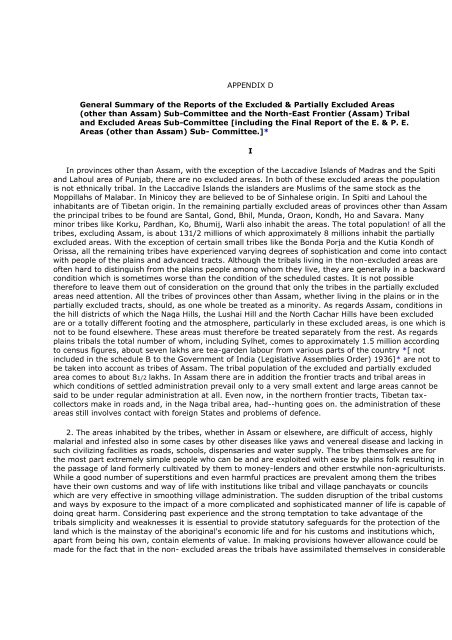
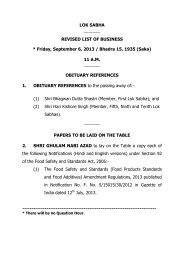
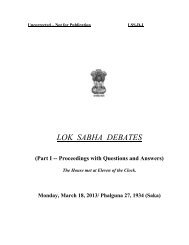

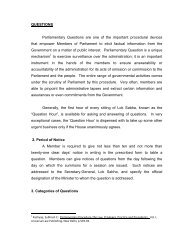
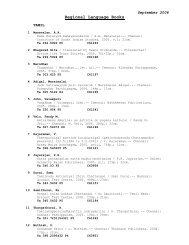

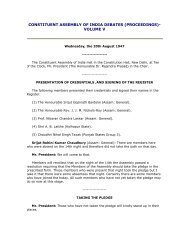
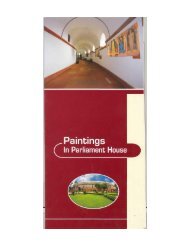
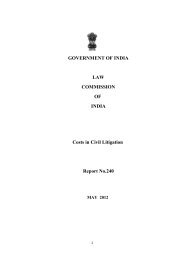
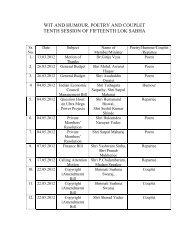
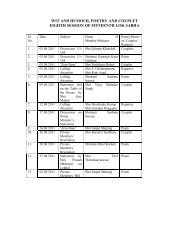

![gÉÉŌ A.]ÉŌ. xÉÉxÉÉ](https://img.yumpu.com/8015720/1/190x245/geeo-aeo-xeexee.jpg?quality=85)
